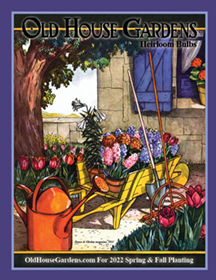Here’s a wealth of information about IRIS from our email Gazette and past catalogs, starting with the most recently published. For other topics, please see our main Newsletter Archives page.
To subscribe to our FREE email newsletter, click here.
What’s That Iris? Get ID Help from Experts Online

Like many gardeners, you may have some beloved plants in your garden that have lost their names. Calling them “Great-Grandma’s rose” or “that daffodil we found in the woods” doesn’t make them any less wonderful, but sometimes you may wish you knew their real name.
If it’s an iris you’re wondering about, you can now ask the Historic Iris Preservation Society about it. On the HIPS homepage, there’s a green box that says “Need help with iris ID? Click here.” Do that and you’ll be taken to their ID Central.
Don’t be daunted by the long introduction and instructions for filling out the application. All you need to know is that it’s hard to identify nameless iris – roughly 70,000 have been introduced, many look a lot alike, and colors often vary depending on climate and soils – and that “I don’t know” is an acceptable answer to any of the questions.
Do read the “Photo Request” section which explains how and when to take the three required close-ups of your nameless iris. Then enter its height, bloom size, fragrance, and so on, upload your photos, and send it.
If you’d prefer, you can mail in your information and photos. Either way, you’ll get a response from the HIPS experts, and – although identifying an iris is always a longshot – there’s at least a chance that your nameless iris will no longer be nameless. Good luck! (May, 2019)
Great Companions to Plant with Your Iris this Spring
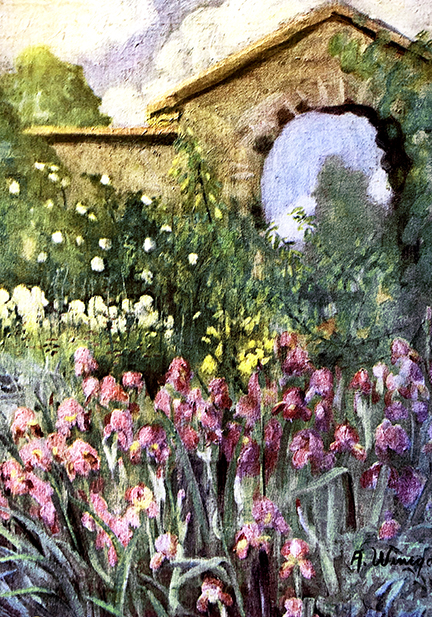
The right companion can make any plant in your garden look better. For bearded iris, here are some tips from two of America’s greatest garden writers.
For June borders that are “a joy indeed,” Louise Beebe Wilder in her 1927 book My Garden recommends intermingling iris (as in this painting from another of her books) with “tall blue and white lupines, lemon lilies [Hemerocallis flava], foxgloves, and peach-leaved campanulas, with a background of Persian lilacs and such free-growing roses as ‘Stanwell’s Perpetual’, ‘Madame Plantier’, and the yellow briers – ‘Harisoni’ and the Persian – and edged with double white pinks and Nepeta mussini [catmint].”
John Wister in his 1930 The Iris recommends some of the same plants and adds to the list: “Good garden combinations can be made with a background of Spirea ‘Van Houttei’, Philadelphus coronarius [mock orange], and kerria with lavender iris and salmon pink Oriental poppies. Pink iris [such as our ‘Queen of May’ and ‘Caprice’] go equally well with this. Gypsophila [baby’s-breath] statice, clove pinks, Nepeta mussini [catmint], Anchusa [Italian bugloss], and lupines are but a few of the many plants that gardeners have used successfully with various irises.”
With their smaller flowers and rugged constitutions, heirloom iris often combine more harmoniously in gardens than modern cultivars do. We’re shipping a dozen of the best for planting in April, and now is the time to order! (March 2019)
Two Cedric Morris Exhibits – and Skyrocketing Prices
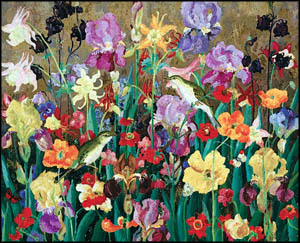
Appreciation continues to grow for artist and iris breeder Cedric Morris whose peachy-pink ‘Edward of Windsor’ sold out early for us this past spring.
In London, two exhibits of Morris’s work are drawing crowds. His landscape paintings are featured at the Philip Mould Gallery in “Cedric Morris: Beyond the Garden Wall,” while his flower paintings are showcased at the Garden Museum in “Cedric Morris: Artist Plantsman.” The Garden Museum exhibit was accompanied in season by a display of Morris’s iris organized by the celebrated garden designer Dan Pearson.
Prices for Morris’s paintings are also skyrocketing – up 1,500% since 2014 according to a recent article in the London Telegraph. Last fall a couple of his landscapes from David Bowie’s personal art collection sold for over $65,000 each, but that’s small change compared to the prices being fetched by his flower paintings “which have raced ahead, like tulip mania.” The record was set last August by July Flowers and Wood Warblers (pictured here) which a London gallery bought for $223,000 – and which is now being offered for just under $400,000.
Although Morris’s paintings may be beyond the reach of most of us, his ‘Edward of Windsor’ iris is much more affordable. For an email alert when it’s for sale again July 1 (along with the rest of our spring-planted bulbs), simply click the link now in our description of it online. (June 2018)
Fabulous Facebook Page for Historic Iris
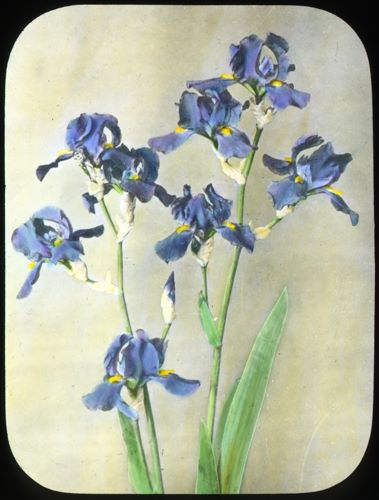
If you’re a fan of heirloom iris, and you’re on Facebook, we think you’ll enjoy the Facebook page of the Historic Iris Preservation Society.
Launched in 2011, it includes antique images and modern photos along with helpful tips and occasional links to other online resources. It has over 3000 followers, including us, and you could be next! Check it out at facebook.com/HISTORICIRIS/. And bravo, HIPS! (Mar. 2018)
Warm Winter Woes: Iris “Lightbulbs” and Scanty Bloom
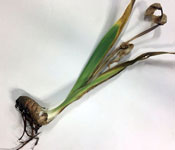
Warmer than usual winters can cause all sorts of problems for plants, including bearded iris. In a recent post at the AIS blog, World of Irises, Bonnie Nichols of zone-8a Dallas explains:
“In December [last year] when the Christmas Day temperature was 82 degrees . . . , we knew the iris bloom season was in jeopardy. And, it didn’t get better when on January 31 the high was 79 degrees.
“When I saw various bearded irises blooming in December and January, I asked friends if they thought it was rebloom or what would have been our spring bloom. We all had no idea. In April, we knew [it] was the ‘spring’ bloom because we . . . had no additional bloom. Maybe 20% of tall bearded irises bloomed. . . .
“We saw more than normal increases on some of the plants because they did not use their energy to bloom. On other plants we noticed something that we had not had much experience with – ‘lightbulb’ rhizomes. Lightbulbs are rhizomes with no increases and the roots wither away. . . . The rhizome increases in size and twists slightly as if it is pushed out of the ground. [If it blooms] the stalk comes up in the middle of the fan and dies back quickly. The rhizome eventually dries up and dies also. . . .”
Commenting on Bonnie’s post, Phil Williams offered an alternative explanation: “Strong root growth is what produces good spring bloom here. Makes me wonder if the prolonged heat [in summer and fall] might have created a false dormancy . . . , and the plants did not root deeply.”
Either way, warmer temperatures are the culprit. Is that global warming? Bonnie says she’s not sure but “I’m beginning to believe it is.” (Dec. 2017)
Iris by an Artist: The Living Masterpieces of Cedric Morris
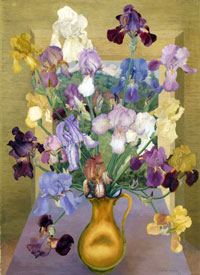
Is it too early to think about spring planting?
Not if you want to snag a rhizome or two of ‘Edward of Windsor’, one of the most intriguing iris we’ve ever offered. Some call it soft pink, others pale orange, but either way it’s a light, dreamy pastel color with a surprisingly bright tangerine beard.
Unusual colors are one of the hallmarks of iris bred by British artist Cedric Morris (1889-1982) whose paintings hang today in museums around the world. Morris painted in what has been called “a distinctive and often rather primitive post-Impressionist style,” and for more than 40 years students flocked to the art school he conducted at his home, Benton End, in the English countryside.
Morris developed extensive gardens there, said to be inspired by Monet’s at Giverny, and in the early 1940s he began breeding iris. He eventually registered 45 of the best with the American Iris Society, often with names such as ‘Benton Rubeo’ (named for his pet macaw) and ‘Benton Cordelia’ (winner of the British Dykes Medal in 1955).
Unfortunately almost all of these had disappeared from commerce by the time Sissinghurst’s head gardener Sarah Cook discovered a long-lost label for ‘Benton Nigel’ in the gardens there. After taking early retirement in 2004, Sarah launched a quest to rediscover all of Morris’s iris, and today she’s nurturing some 25 of them as holder of Plant Heritage’s National Collection of Cedric Morris Iris.
Learn more about Morris and his iris here (although please note that the photo labeled ‘Edward of Windsor’ is NOT that iris), view dozens of his paintings here (you may need to be patient as the images load), and if you like what you see, why not order now to enjoy a bit of his floral art in your own backyard! (Nov. 2017)
Protect Peonies and Iris with an Easy Fall Clean-Up

For healthier plants and even more flowers, give your peonies and iris a simple fall clean-up.
PEONIES – Although peonies are generally care-free, they can be afflicted by powdery mildew (pictured here) and other fungal diseases. To prevent spores from overwintering, cut peony stems as close to the ground as possible, carefully bagging everything as you go, and dispose in the trash instead of composting. For best results, do this earlier rather than later, before the leaves dry up.
IRIS – Fall is also the best time to control iris borers. Borers hatch in spring from eggs laid in fall on iris leaves and anything similar that’s close by. To destroy them, simply wait until after a good hard frost kills the adult moths and then (a) cut back all leaves to a couple of inches and (b) remove, bag, and trash – don’t compost – the clippings and any debris or mulch that’s near the plants.
Simple, right? And your plants will reward you! (Sept. 2017)
Guardian Gardens: Crowd-Sourcing Preservation
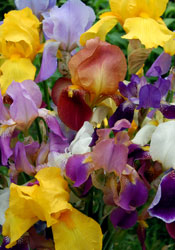
Last year the Historic Iris Preservation Society (HIPS) launched an exciting grassroots effort to save the world’s rarest iris – and they’re hoping you’ll help.
The Guardian Gardens network is a far-flung group of iris enthusiasts who’ve agreed to grow and share varieties that are most at risk of extinction. The goal is to have five different gardeners growing each of these rare iris so that even if one or two lose theirs it won’t be lost forever.
You don’t have to be an expert to help, says Doug Paschall, the program’s coordinator. If you have experience growing iris and a sunny spot that’s big enough for four or five rhizomes of a few varieties, he’d love to hear from you.
“We have irises waiting to be adopted,” Doug adds, and mid-summer is the ideal time for planting them. To learn more, check out the Guardian Gardens FAQ at the HIPS website.
And here’s a thought: wouldn’t it be great if other plant societies sponsored preservation efforts like this? In fact, if you feel inspired to launch a Guardian Gardens project for daffodils or dahlias or daylilies or glads or peonies – all of which have active national societies devoted to them – please let us know and we’ll help spread the word about it here. Working together, we can not only “Save the Iris” but “Save the Other Flowers, Too!” (June 2017)
History in Bloom: Presby Memorial Iris Garden
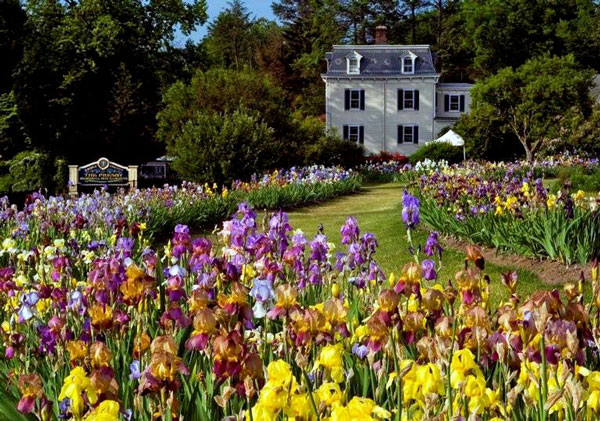
One of the world’s greatest collections of historic iris is celebrating its 90th anniversary this month, and you’re invited to the party!
Established in Montclair, New Jersey, in 1927, the Presby Memorial Iris Garden today includes nearly 14,000 iris plants of 1500 varieties. Every year from mid-May through the first week in June, over 100,000 flowers bloom there in a dazzling display that’s come to be called “the rainbow on the hill.”
To celebrate the big anniversary, on weekend afternoons in May volunteers will be serving cookies and lemonade on the porch of the Garden’s historic Walther House. Iris dug from Presby’s vast collection will also be for sale on weekends starting this Friday from 10:00-3:00.
If you visit, please share a photo or two on our Facebook page – and even though admission is free, we hope you’ll donate generously to support the important work Presby is doing to preserve great old iris for all of us. (May 2017)
Meet Alan Shipp, the Hyacinth Master

With a collection of 243 hyacinth varieties dating back as far as the 1700s, our good friend Alan Shipp is an inspiring example of what one person can do to save our incredibly rich garden heritage.
Although we’ve been the sole US source for Alan’s hyacinths for many years, and we’re proud to call him a friend, we learned a lot we never knew about him in an engaging post at the British blog Spitalfields Life. Alan is a great story-teller with a jolly sense of humor, and the blog’s author captures him well.
Alan talks about how his family farm got its start when his grandfather won a pony in a raffle, how he learned how to propagate hyacinths from a slug, and how the “extinct” 1767 double white-with-red-eyes ‘Gloria Mundi’ was rediscovered in a tiny village in Romania. You can read it all, and enjoy photos of Alan’s hyacinth fields in bloom, at spitalfieldslife.com/2017/03/26/alan-shipp-hyacinth-grower/.
(To meet USDA import requirements, Alan has to grow our hyacinths in a special field. As soon as we learn what he’ll have available for us this fall, we’ll announce it here in our newsletter.) (May2017)
Paradise Lost: Winston-Salem’s Municipal Iris Garden
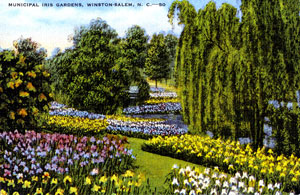
Does your city have a municipal iris garden?
That seems very unlikely, which is why I was so surprised when this postcard arrived in the mail recently.
It’s a modern reproduction of a 1949 postcard showing the “Municipal Iris Gardens, Winston-Salem, NC.” On the back it reads: “The Municipal Iris Garden contains 20,000 plants, of 525 varieties. The blossoms range from pure white to deep purple, gold, and dark red, and are at their best during May. Weeping willows and rustic bridges add to the beauty of the rolling parkway.”
20,000 plants – of 525 varieties! I had to know more, so I contacted the folks who sent the card – which announces the 2017 Conference on Restoring Southern Landscapes and Gardens– and here’s what I learned.
“The development of the gardens to their present state of beauty is a typical Cinderella story,” the Twin City Sentinel reported in 1938, “with many local iris growers acting as fairy godmothers.”
It all started in the early 1920s when a new neighborhood was laid out which included a four-acre “gully-way” that was left untouched “since there seemed no other purpose it could serve.”
Although today we’d probably consider it a valuable natural area, times were different then and in 1931 a doctor who lived nearby urged the city to beautify it with iris donated from his own extensive gardens. Iris were enormously popular at that time, and before long other neighbors joined the campaign and the Municipal Iris Garden was born.
The city parks department cleared the land, planted weeping willow trees, built stone and rustic-work bridges over the stream, and laid out gracefully curving beds. By 1938 the Twin City Sentinel reported that “Winston-Salem’s iris attract visitors from all parts of the state. From an unattractive gully the city parks department has transformed Runnymede Parkway into one of the most popular parks in the city.”
But that was then. By the early 1950s the iris had been replaced with lower-maintenance azaleas, and today even those are gone. The stone bridges still stand, though, bearing silent witness to the park’s glory days – and who knows what the next chapter might be for this Cinderella gully-way?
For additional images, visit digitalforsyth.org/photos/browse/places-gardens-runnymede-iris-gardens.
For your own little iris paradise, see the 17 heirloom iris we’re shipping this spring.
And many thanks to Camilla Wilcox, Kay Bergey, and Martha Hartley for sharing this remarkable story with me! (Feb. 2017)
5 Timeless Iris: High Praise from the First President of the AIS
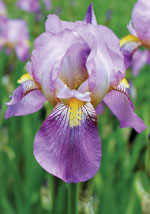
The great horticulturist John Wister helped found the American Iris Society in 1920 and served as its first president for fourteen years.
At that time, iris were exceedingly popular and scores of exciting new varieties were being introduced every year. Yet in his small book The Iris published in 1930, Wister wrote that “the more of the new things I see, the more I am convinced of the worthiness of some of our oldest varieties” – such as these:
‘Pallida Dalmatica’ (1597) – “There is nothing . . . in the whole range of iris that is finer than the true ‘Pallida Dalmatica’,” Wister wrote, adding that planting it with lemon lily (Hemerocallis lilioasphodelus) is “one of the most famous” garden combinations with iris.
Germanica (by 1500) – “The purple flag of our grandmothers’ garden . . . should never be omitted for . . . it makes a striking garden picture.”
‘Flavescens’ (1813) – Among pale yellow iris “there is nothing to surpass the variety ‘Flavescens’, well known in every old garden in this country.”
‘Queen of May’ (1859, pictured here) – “On the pink side of the lavenders, the old ‘Queen of May’ is . . . still one of the best.” It is “lovely,” he added, “with white and pink lupines and pink Dianthus.”
‘Mrs. Horace Darwin’ (1888) – Although “rather dwarf,” this white iris is “wonderfully free blooming. It is unexcelled for massing and should be used in every garden in quantities.”
Of course you don’t have to be an expert to enjoy these timeless treasures. Just order yours now for April delivery! (Jan. 2017)
Garden Books for Giving and Getting

Although the cold, short days of winter aren’t the best for gardening, they’re perfect for garden reading – and books make great holiday gifts. Here are five new ones I’m hoping to enjoy before spring returns.
Rescuing Eden: Preserving America’s Historic Gardens, by Curtice Taylor and Caroline Seebohm: “Most gardens do not survive their creators, being sold off, dug out, or, if not utterly destroyed, then so drastically changed as to be sadly unrecognizable. The 28 remarkable properties in this book” – ranging from Middleton Place plantation to the gardens of Alcatraz – “are happy exceptions to that rule, rescued from near-obliteration because of historic connections. . . . Some are still in the process of renovation, and others will never be fully restored, but all offer rare glimpses into this country’s horticultural history.” (reviewed by Adam Levine in Country Gardens)
Garden Flora: The Natural and Cultural History of the Plants in Your Garden, by Noel Kingsbury: “This must be the most beautiful book of the publishing season, with an oversize format rich in botanical art and historic and contemporary photos. Every page is stunning, a revelation in art and text of flora’s long and curious history. Kingsbury’s writing is a lively backstory to what we grow in our gardens” – including most of the bulbs we offer – and “it’s also right up to the minute with insight on current plant breeding and a poignant look at the plants we’ve lost.” (reviewed by Val Easton in the Seattle Times)
The Botanical Treasury, by Christopher Mills: “The excitement of discovering a new plant is almost tangible in this lavish collection of plant histories. A delightful compendium of 40 plants from around the world, The Botanical Treasury tells the story of each one through a fascinating mix of botanical illustrations, letters sent to Kew from plant hunters, and reprinted extracts from botanical periodicals. . . . The book also includes forty reproduced prints of featured plants which can be framed – the icing on the cake of this tremendous and fascinating collection.” (reviewed in The English Garden)
A Garden for the President: A History of the White House Grounds, by Jonathan Pliska: “The White House grounds are the oldest continually maintained ornamental landscape in the United States. Handsomely illustrated with historical images and newly commissioned photography, A Garden for the President explores not only the relationship between the White House and its landscape but also the evolution of its design; the public and private uses . . . ; and the cultivation of the grounds with a focus on the specimen trees, vegetable and ornamental gardens, and conservatories. (reviewed by the White House Historical Association)
Bliss Irises: Family and Flowers, The Journey to a National Collection, by Anne Milner: “Anne Milner blends personal history with gardening in this beautifully illustrated book. Her story starts with the discovery that her grandfather’s cousin was . . . Arthur J. Bliss, who introduced ‘Dominion’, a ground-breaking purple iris that made him world famous. . . . The book’s second half focuses on the [more than 175 iris Bliss introduced], with detailed information about the plants, accompanied by photographs, watercolors, and line drawings.” (reviewed in Plant Heritage) (Dec. 2016)
Gray is Cool — And so is 500-Year-Old ‘Florentina’ Iris
Once scorned as boring, gray is now one of the coolest colors around, as anyone knows who’s picked up a shelter magazine or watched a home improvement show recently.
But gray flowers?? Believe it or not, one of the most beautiful iris I know is the luminous, pewter-gray ‘Florentina’, and two of the 20th century’s leading horticulturists agree that it’s something special.
In her 1916 best-seller My Garden, Louise Beebe Wilder called ‘Florentina’ “a charming inhabitant of old gardens” and “one of the loveliest of irises,” and in 1930 the first president of the American Iris Society, John Wister, wrote that it “well deserves all its popularity, as nothing is better either for massing or cutting.”
Wister described its unique color as “pearly white,” and some gardeners see it as a very pale lavender, but to Wilder and me it’s truly gray. Wilder called it “French gray,” a pale gray warmed by a hint of brown or gold, but to my eye it most resembles the silvery gray of softly polished pewter.
‘Florentina’ is “invaluable to us in creating May pictures,” Wilder wrote, no doubt in part because gray goes well with just about everything. She suggested combining it with pink bleeding heart and Single Late tulips, yellow leopard’s bane (Doronicum), and lavender woodland phlox (Phlox divaricata), or planting it “in spreading groups near pink-flowered crabapple trees.”
So, are you cool enough for this gloriously gray beauty? Order a few now for delivery in April! (Jan. 2016)
“Broken-Color” Iris: From ‘Loreley’ to ‘Bewilderbeast’
New to our catalog for delivery in April is ‘Loreley’, one of the most popular iris of the 20th century. Introduced in 1909, ‘Loreley’ was one of the first “broken-color” iris, a type that has become increasingly popular in recent years.
Unlike broken tulips whose stripes are caused by a benign virus, broken-color iris are irregularly splashed with contrasting colors due to a genetic mutation. Although at least one dates to the 19th century — ‘Victorine’ of 1840 — most early examples were probably discarded as misfits. The enormous popularity of ‘Loreley’, however, helped iris breeders begin to see these “flawed” iris in a whole new light.
Varieties with names like ‘Kaleidoscope’ and ‘Joseph’s Coat’ followed, but ‘Loreley’ remained the most popular broken-color iris until the elaborately patterned, purple and white ‘Batik’ was introduced in 1986. ‘Batik’ won the AIS’s top prize for iris its size and became a huge commercial success, opening the door for the scores of broken-color iris introduced since then, often with amusing names such as ‘Bewilderbeast’.
As our friend Mike Unser writes in his excellent blog post about the history of broken-color iris, “No two blooms are ever just alike, and they can create a very lively and exuberant effect in the flower garden.” To see for yourself, order ‘Loreley’ now for delivery in April! (Dec. 2015)
3 Experts, 3 Centuries, 3 Great Iris
Sure, we think our heirloom iris are awesome, but there’s no need to take our word for it. Here’s what experts in 1597, 1930, and 2012 had to say about three of our favorites:
I. pallida ‘Dalmatica’ — In 1597 John Gerard praised this ancient iris in his landmark Herbal, saying it “hath leaves much broader, thicker, and more closely compact together” than other iris, “like wings, or the fins of a whale fish.” From these “riseth up a stalk of four feet high, as myself did measure oft times in my garden,” with “fair large flowers of a light blue” which “smell exceedingly sweet, much like the orange flower.”
‘Mrs. Horace Darwin’ — More than three centuries later, famed horticulturist John Wister writing in his book The Iris praised this petite beauty as one of three whites that “can never be omitted.” He called it “wonderfully free blooming,” and added that “it is unexcelled for massing and should be used in every garden in quantities.”
‘Quaker Lady’ — Last but not least, Kelly Norris who grew up on his family’s iris farm and now works at the Greater Des Moines Botanical Garden, praised this subtle flower in his 2012 Guide to Bearded Iris: Cultivating the Rainbow, saying it “has a soft-spoken princess charm that stops me in my tracks each spring. . . . If your garden needs a vintage touch in lovely pastel hues of bronze and lilac, look no further.” (Feb. 2015)
What’s That Iris? See 100s of Photos and More at Revamped HistoricIris.org
The already excellent website of the Historic Iris Preservation Society (HIPS) just got better — and a new address, www.HistoricIris.org — thanks to an ongoing upgrade by webmaster Christine Woodward. Although I miss the charming look of the old site (by Mike Unser, a major hero of historic iris), the revised site offers a lot more information. My favorite section is still the Gallery of photos with descriptions from old catalogs, and now you can sort it by era (choose “pre-1900,” for example, and you’ll get a list of 49 names) or use the “Comparison Display” feature to look at two similarly colored iris side by side. In the Resources section there are almost 60 reprinted articles dating from as far back as 1887, and don’t miss the former HIPS e-zine, Flags. The annual Rhizome Sale fund-raiser is online now, too, and if you move fast you can order from a list of over 300 heirloom varieties (including some that we donated) for just $6.50 each. There’s a lot more to explore and enjoy at the HIPS site, and if you like what you see there I hope you’ll consider joining HIPS. It’s a terrific organization doing important work to preserve our garden heritage. (June 2014)
Who’s That Growing in My Garden? “Singularly Fearless” Mrs. George Darwin
For the first time this spring we’re offering the elegant little iris called ‘Mrs. George Darwin’. Like its equally wonderful sister-in-law ‘Mrs. Horace Darwin’ which we offered last year, it was bred in the late 1800s by Sir Michael Foster, a Cambridge physiology professor who laid the foundations for modern iris by crossing garden forms with unusual varieties — including the first tetraploids — sent to him by missionaries and travelers.
But who was Mrs. George Darwin? Wikipedia offers a short biography along with a charming portrait of her dressed all in white, like her namesake iris. Philadelphia-born Martha du Puy — who was always known as Maud — met her husband while visiting relatives in England. George was the son of the great Charles Darwin and a noted astronomer at Cambridge where the young couple became lifelong friends with Foster.
I learned a lot more in the entertaining Period Piece: A Cambridge Childhood by Maud’s daughter Gwen Raverat. Her mother’s “casual happy-go-luckiness . . . was one of her most attractive qualities,” Raverat writes, but she was also “singularly fearless” and “always on the side of progress,” with a “sturdy American belief in independence” that made her “encourage us to do things for ourselves, unlike the well brought up English children of our class, some of whom did not know that you could make a bed yourself.” When Maud died in 1947 at the age of 88, her obituary noted her campaigning for women police officers.
Although iris aren’t mentioned in the 66-page preview of Period Piece at Google Books, there is a funny account of Maud’s first meeting with Foster, who seemed a bit tipsy. Even better, Raverat’s description of Maud’s physical appearance suggests why Foster named this particular white iris with its touches of gold and purple for her. “My mother . . . had golden-brown hair and dark blue eyes and such a lovely complexion that people often thought that she was made up.” (Jan. 2014)
Toast the Holidays with . . . Heirloom Iris?
With the curiosity of a scientist and the writing skills of a master story-teller, Amy Stewart is one of my favorite authors. In her 2013 New York Times best-seller The Drunken Botanist, she explores the hundreds of “plants that create the world’s great drinks,” from barley and hops to obscurities such as quandong, sloe berry, and even a couple of centuries-old iris:
“The pharmacy and perfumery of Santa Maria Novella, established by Dominican friars in Florence in 1221, gained notoriety for its use of the rhizomes of iris. They were not the first — Greek and Roman writings mention it — but their perfumes, cordials, and powders contained liberal doses of this rare and precious substance.
“Orris was popular not so much for its fragrance — although it does contain a compound called irone that gives it a faint violet smell — but as a fixative, holding other fragrances or flavors in place by contributing a missing atom that would otherwise make the fragrance volatile and easily released from the solution it is suspended in.
“None of this chemistry was understood at first. Perfumers and distillers would also not have understood why the rhizomes had to dry for two to three years before they become effective as a fixative. We now know that it takes that long for a slow oxidation process to occur, . . [which] causes irone to form . . . .
“Only about 173 acres of orris are cultivated worldwide. Most of the orris is either I. pallida ‘Dalmatica’, grown in Italy, or . . . I. germanica var. Florentina, grown in Morocco, China, and India. I. germanica ‘Albicans’ is also used . . . .
“To extract the orris, the rhizome must first be pulverized and steam-distilled to produce a waxy substance called orris butter, or beurre d’iris. Then alcohol is used to extract an absolute, which is . . . a stronger version of an essential oil.
“Orris is found in nearly every gin and in many other spirits. Its popularity in perfume is due to the fact that it not only holds the fragrance in place but clings to the skin as well. It also happens to be a very common allergen, which explains why allergy sufferers might be sensitive to cosmetics and other fragrances — as well as gin.”
See a field of pallida ‘Dalmatica’ farmed in Italy at oldhousegardens.com/PallidaField.aspx . (Dec. 2013)
Adventures in Forcing: Bearded Iris
We’ve enjoyed forcing all sorts of bulbs into winter bloom, but we never even considered trying it with bearded iris until we read this suggestion from almost 100 years ago by the pioneering iris evangelist Charles S. Harrison. In his popular Manual on the Iris he writes:
“Take some strong clumps, not too large, say two or three years old. Leave the earth on them, take them up just before the ground freezes, put them in large pots and place in a cool cellar. It will not hurt them to freeze. If they do, let the frost come out gradually. Then bring them up to the light and put them in the south window and you can have flowers through February and March, and by planting white ones you can have beautiful Easter flowers. . . . Grown in the house they will be more beautiful and delicate than if grown out of doors. . . . .
“The expense will be small and the results extremely satisfactory. Sheltered from the weather they will continue longer in bloom than out of doors. Other winter flowers are expensive but these you can secure at little cost and when you get started you can get them from your own garden. It will be found that this immense family will furnish such a variety in bloom and in color they will be a constant surprise and delight.”
Will this actually work? We have to admit we’re a bit skeptical, but we just potted up a couple of iris for our unheated back room and a couple more for our basement refrigerator. (We doubt that any modern cellar is cold enough to keep iris dormant.) If you’re adventurous enough to try it yourself, please let us know how it goes for you! (Nov. 2013)
See What You’ll Get: Fat, Freshly Dug, Spring-Shipped Iris (for Zone 8, Too)
We do bearded iris differently. Instead of shipping dry rhizomes in mid-summer the way everyone else does, we dig newly sprouting plants out of the barely thawed ground here in early April and ship them that very same day. With good care they’ll often bloom their first summer, and by the next year they’ll be two or three times as big as their summer-planted kin — making them, in our opinion, a great deal. To see a big, beautiful example of what we’ll be shipping this spring, click the link for freshly dug plants at the beginning of our iris section.
And here’s good news for gardeners in zone 8 of the South and Southwest. Despite our warnings that planting iris there in the heat of April might not work, almost all of our customers who tried it reported that our iris thrived — so now you, too, can order them with confidence. Thanks to the iris-lovers in zone 8 South and Southwest who helped us figure this out — and enjoy! (March 2013)
Fragrant Iris: A 1917 Expert’s Top Picks
If you’d like some fragrant iris to plant this spring, here are seven that Walter Stager recommended in his 1917 Tall Bearded Iris. We’re currently offering three of them, and we’re increasing ‘Monsignor’ and ‘Fairy’ to offer in the future:
“Dalmatica, Florentina, Monsignor, and Walhalla are among the most fragrant. Fairy is perhaps the most fragrant of all, and Caprice and Madame Pacquitte have an especially delicious fragrance.”
For six more, see the Fragrance column in our Heirloom Iris Chart. Then do your nose a favor and order now for April delivery! (Feb. 2013)
Pallida Dalmatica in the Fields of Italy (and Your Garden)
The grape-scented, lavender-blue iris known as I. pallida ‘Dalmatica’ has been used in perfumery since ancient times, and it’s still being farmed for that purpose today — as our good customer Debbie Hughes of Wellsville, Kansas, discovered while vacationing in Tuscany. Debbie’s photo of a field of Iris pallida inspired us to learn more, and a Google search led us to the Sagrona vineyard, “a small family vineyard in the heart of Chianti” where I. pallida is grown amid the grapes as it has been for centuries.
As you’ll see at Sagrona.com, it’s not the iris flowers that are harvested but the rhizomes. Peeled by hand and dried for two to five years, they develop a violet-like scent and fixative properties that preserve the chemical structure of other fragrances, prolonging their aroma. Ground and distilled, a ton of dried rhizomes — known as orris root — yields 4.5 pounds of a thick, oily, and very expensive substance called orris butter which is still widely used in making high-end fragrances — and gin.
But there are many other reasons to grow this great old iris. “Among its sterling qualities,” writes Sydney Edison in A Patchwork Garden, “are a tenacious resistance to borers, stems strong enough to support the medium-sized blossoms, and superb gray-green foliage that is an asset in the garden instead of an eyesore. . . . A wild species found originally in Dalmatia [roughly the former Yugoslavia], Iris pallida appears somewhere in the family tree of most modern cultivars but it has none of their faults. . . . I prefer this lovely, deliciously scented hand-me-down to all other tall bearded irises.” (Dec. 2012)
Beating Iris Borers — and Weaving Baskets from Iris Leaves
Right now is the best time to protect your heirloom iris from borers with a simple garden clean-up. It’s easy, organic, and as a bonus you can use the leaves you remove to make some very interesting baskets.
In the fall, iris borer moths lay their eggs on iris leaves and anything similar that’s close by. In the spring, the eggs hatch into tiny grubs that chew their way down into the rhizomes and wreak havoc. So the trick is to eliminate the eggs in the fall. To do this, simply wait until after a good hard frost (which kills the adult moths) and then (a) cut back all iris leaves to a couple of inches and (b) remove all dead leaves and stalks as well as any debris and mulch that’s near the plants. To be safe, don’t compost this stuff. Burn it or throw it out with the garbage — or save the best leaves to make into baskets.
Although we’ve never looked at the browning, beat-up leaves of our iris and thought, “Hey, those would be great for basket-making,” our good customer Frances Garrison makes it look easy and appealing in her FaireGarden blog. If you decide to try it, please send us a photo of your results and we’ll share it with our readers — and no matter how your basket turns out, we promise not to laugh. (Nov. 2012)
Investing in Beauty: A Timeless Tip from 1916
We stumbled upon this unusual investment tip in the 1916 Manual on the Iris by Nebraska nurseryman and minister Charles S. Harrison:
“Beauty is Wealth. Raise a plenty of it and be rich. No investment can pay better. You build a new house at great expense and it begins to deteriorate from the moment you enter it. In a short time your beautiful furniture becomes second hand.
“Out in your yard ... peonies double every two years, which gives you 50 percent interest on your money. And the radiant iris in ‘garments of woven delight’ gives you ten from one in two years. Beautify your grounds and double the value of your land. It makes a great difference whether your yard is a landscape of beauty or a pasture for pigs or a hospital for disabled machinery.” (August 2012)
Two Great Resources for Heirloom Iris Lovers
Historic Iris Preservation Society — Founded in 1988, this dedicated group offers help in identifying and finding heirloom iris, an annual rhizome sale, a journal, reprinted works, and a terrific website and e-zine at HistoricIris.org. The site is free and the rest is a mere $10/year.
Classic Irises and the Men and Women Who Created Them — This exhaustively researched history by Clarence Mahan tells the fascinating stories of the people who developed the great irises of the 19th and early 20th centuries. It’s not light reading, but it is superb. (2011-12 catalog)
1927 Advice: Companion Plants for “Loveliest” Iris
Louise Beebe Wilder was a popular garden writer in the early 1900s who’s been called “America’s Gertrude Jekyll.” Here’s some advice from her 1927 My Garden about one of our favorite iris:
“‘Florentina’ . . . is one of the loveliest of irises, and its French-gray crepe flowers are invaluable to us in creating May pictures. It is fine with Dicentras [bleeding hearts] and tall pink tulips of the Cottage and Darwin types; with the yellow Doronicums [leopard’s bane] and the pretty lavender-flowered Phlox divaricata; and is splendid in spreading groups near pink-flowered crabapple trees.” (March 2012)
Now’s the Time: Fall Clean-Up Beats Iris Borers
Now is the best time to conquer iris borers — and it’s easy. Cleanliness is the key.
In the fall, iris borer moths lay their eggs on iris leaves and anything similar that’s close by. In the spring, the eggs hatch into tiny grubs that crawl up the leaves and then chew their way down into the rhizomes where they wreak havoc. By eliminating the eggs in the fall, you’ll save yourself a lot of grief.
Simply wait till after a good hard frost (which kills the adult moths) and then (a) cut back all iris leaves to a couple of inches and (b) remove all dead leaves and stalks as well as any debris and mulch that’s near the plants. To be safe, don’t compost this stuff; burn it or throw it out with the garbage.
Repeat this simple, poison-free clean-up every fall and you’ll have very little problem with borers. Now isn’t that easy? Learn more at http://blogs.k-state.edu/kansasbugs/tag/iris-borers/ . (Nov. 2011)
Two Tough Survivors: ‘Pallida Dalmatica’ and ‘Flavescens’
We doubled our iris offerings for the coming year, thanks in part to the generosity of some of our Old West Side neighbors who shared their heirloom iris with us. Many of them passed along stories with their rhizomes, too. Jean Henry, for example, told us that her ‘Pallida Dalmatica’ came from her Iowa grandmother who got it from the woman who babysat for Jean’s father and later Jean herself. It was “the standard iris” in that area, but Violet Kieffer — pronounced “Wiolet,” Jean explained — was “very proud of them” and “she’d be thrilled to know they made it into your catalog.”
‘Flavescens’ is another very old iris that will grow just about anywhere. For example, a few years ago my wife Jane and I were walking along the wooded, hillside path that circles a small lake in the Brighton State Recreation Area. At one point the hillside was so steep that the ground to our left was almost at eye level, and there in the crowded, densely shaded undergrowth I was shocked to see a few scrawny bearded iris. They must have been survivors from a long-forgotten home that once stood where now wilderness ruled. I was so impressed that I collected one small rhizome and brought it home to a sunny spot in my own garden. This spring it finally bloomed for the first time, and — you guessed it — it was the indomitable ‘Flavescens’. (Aug. 2011)
Site of the Month: “Wild Lakota” Iris and Other Legacy Bulbs
“My favorite old homestead flower is a bearded iris that I’ve nicknamed ‘Wild Lakota’. It has a lovely lemony scent.” So wrote Dennis Kramb of southwest Ohio in the Pacific Bulb Society’s email discussion group. “The roadside places where I’ve found it are nowhere near any existing home,” he continued, “so I can’t imagine how many decades they’ve been able to persist there, untended. I collected a few pieces years ago and now have a big patch of it in my front garden.” That sounded like an iris we ought to offer, but when we looked at Dennis’s photo of it, we discovered we already do. It’s 200-year-old, primrose-yellow ‘Flavescens’.
From roses to daffodils to asparagus, some garden plants are so tough that they can persist in the wild without care for many, many years. Some are so commonly found there that they’ve made it into wildflower guide books where they’re typically marked as “alien” or “garden escape.” Although the Pacific Bulb Society focuses on truly wild bulbs, they’ve included a long list of “Legacy Bulbs” — “bulbs that outlast their owners” — in the Wiki section of their excellent website. You’ll find ‘Flavescens’ and ‘Crimson King’ iris there, along with descriptions and photos of bulbs from almost every genus we sell, from Allium to Zephyranthes. It’s fun to explore, it may help you identify bulbs you’ve found in the wild, and it’s convincing testimony to the staying power of heirlooms. (April 2011)
Sydney Eddison’s Favorite Iris
“I am no longer a fan of the modern bearded irises which I once lusted after,” Sydney Eddison writes in Gardening for a Lifetime, “because borers always wreak havoc with their foliage, chewing the edges of the leaves and coating them with slime. While the plants rarely die, they look so awful that you wish they would.
“The species Iris pallida is a different story. Mine came with the house forty-eight years ago and can still be found in other old gardens. I recently saw it for sale in Williamsburg, Virginia, where the historic gardens contain only plants available in colonial times. This old iris can be easily identified by its bloomy blue-green leaves, which stand at attention throughout the season and are seldom ruined by borers. The three-foot flower stalks bear five or six modest blue-violet flowers that have a delicious scent. And after the brief flowering season in May, the foliage usually remains handsome all season.” (March 2011)
Tough Little ‘Gracchus’ Iris Wins Praise from Virginia to Alaska
Your mother was right. Beauty is more than skin-deep, and that’s true for plants, too. ‘Gracchus’, for example, isn’t an “oh-my-gosh-look-at-that” iris, but it is an exceptional one.
According to an article in the Historic Iris Preservation Society’s Roots (fall 2000), Schreiner’s Iris, the country’s largest iris nursery, is now working to “reintroduce hardiness, disease resistance, and vigor to modern bearded iris using ‘Gracchus’ as the foundation stock.”
The strength and vigor of ‘Gracchus’ has also impressed Straea from Somerville, Massachusetts, who writes at DavesGarden.com, “I love ‘Gracchus’! It produces an amazing number of flowers, and they’re on sturdy stems that don’t bend at all in my windy garden despite often having four or five flowers on them. In addition, it bounced back from an iris borer infestation last year with little intervention on my part (all I did was cut off the worst part of the infestation) and is now more vigorous than ever.”
In Juneau, Alaska, reports Glacierdawg at DavesGarden.com, “‘Gracchus’ has been growing at the Jensen-Olson Arboretum since the property was originally homesteaded in 1904. It blooms well here despite the cool, wet, maritime climate. While no plant is completely maintenance free, this one comes close. A top dressing of compost in late summer and deadheading is all that we do for it.”
And in Portsmouth, Virginia, “‘Gracchus’ is my husband’s favorite iris in my whole garden of 300+ irises,” writes Homefire, also at DavesGarden.com. “It is a fast grower with many flowers. He always enters it in iris shows and it won Best Historic Iris here in 2007. It was introduced in 1884, so for an iris cultivar to remain in existence with people still growing it that long tells its own story. Highly recommended!” (Dec. 2010)
Zac Posen Gives Us a Shout-Out At Vogue.com
For Mother’s Day this year, Vogue.com asked twenty top fashion designers and models — from Vera Wang to Gisele Bundchen — to talk about “the gifts they intend to give or hope to receive.” Our favorite reply came from Zac Posen, the wildly popular Tribeca designer whose “strong, feminine aesthetic has become a favorite of style leaders” such as Kate Winslett, Jennifer Lopez, and Beyonce, and whose off-the-rack collections are currently selling at Target and Saks.
“I plan to give my mother ‘Madame Chereau’ heirloom iris from Old House Gardens,” Zac wrote. “They are the most sought-after iris of the nineteenth century and have a history of staying alive. I remember when I was younger we had a field of iris, which was beautiful! I want to fill a field with irises for my mother one day.”
Thanks, Zac! We hope your mom loves them! (June 2010)
‘Flavescens’ Transcendent: Poster Child for Heirloom Flowers
Here’s a photo that will gladden the hearts of heirloom flower lovers everywhere. Left to fend for itself in the weeds alongside a dirt road not far from Kansas City, pale yellow ‘Flavescens’ iris has multiplied without care into an endless swath of pale, shimmering yellow. (March 2010)
Saving Local Heirlooms at the Pickle Barrel Iris Garden
Some of the most exciting heirloom flowers aren’t found in catalogs or gardens. They’re just out there, in the wild, the last reminders of houses and gardeners that are long gone. In a small town on the shores of Lake Superior, our friend Nancy McDonald decided to collect some of these relics and display them in a living museum of local garden history. Her charming, photo-filled account of the Pickle Barrel House Historic Iris Garden — home now to “Linnamaki Purple,” “Baker Grade” (from the site of a railroad switchman’s cabin), and other “noids” — is an inspiring story that may get you saying, “I could do that!” (March 2010)
Divide Iris and Defeat Borers: Now is the Time!
If your iris plantings have become over-crowded, or you want to share some with friends, now is the time to dig and divide them. “It’s easy, and fun,” our friend Ken Druse wrote recently at RealDirtRadio.com. “I dig up my iris rhizomes with a garden fork when they are dormant — now. Most of the soil will fall off the thick rhizome and reveal slender roots. I trim back the leaves into ‘fans’ and cut off the oldest section of rhizome (which will not bloom again). I dip the rhizome (holding it by the leaves) in a 10% solution of household chlorine bleach for about ten seconds. I set them out to drain on some newspaper, and then replant with the top of the rhizome just at the surface of the soil. Sun-baked rhizomes bloom best.”
“Older varieties of bearded iris do not need dividing as often as newer ones,” Ken adds. To see the six heirlooms we’re offering, click here. To learn more about dividing iris and combating borers, listen to Ken’s July 3 podcast. (July 2009)
Your Feedback, Please: How Are Our Iris Doing?
We shipped bearded iris for the first time this spring, and we’re eager to hear how they’re growing. Have they settled into your garden happily, and did you get blooms this first summer? Our trial-runs were successful, but we want to make sure we’re delivering iris in a way that works for all of our customers.
Though most sources ship them in mid-summer, a separate, iris-only shipping season would mean our customers would have to order a full $30 worth (our minimum order) instead of just one or two. With spring delivery, on the other hand, most gardeners will get bigger plants faster along with blooms in a couple of months rather than a year. The way we see it, that’s a better way to serve our customers and to help preserve heirloom iris. (June 2009)
If Javelinas Roam Your Garden, Plant Iris!
Though we didn’t include bearded iris on our recent list of animal-resistant bulbs, our good customer Louise Coulter of Payson, Arizona, emailed us to vouch for them:
“In my area which is at 5,000 feet in Arizona’s northern section there is an animal called javelina or wild pig. With cloven hoofs, tusks, and large foraging families, it devastates unprotected bulbs in gardens — except for iris. Seems they can’t eat iris. So at thousands of homes here, where the yards are unfenced, iris naturalize and are ubiquitous. Seems the local nurseries obtained a limited color palette of them each year, so one can almost tell how old the bulbs are by their color. For years one could only get shades of variegated purple and a lovely pale salmon.” (Nov. 2008)












